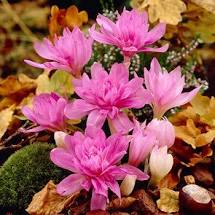 The fall bulb catalogs are arriving day by day, their pages full of impossibly big tulips, daffodils of every description, and hyacinths whose portraits are so vibrant that you can almost smell them. I really should get my orders in—and I will in a week or so–but for right now I need more immediate gratification.
The fall bulb catalogs are arriving day by day, their pages full of impossibly big tulips, daffodils of every description, and hyacinths whose portraits are so vibrant that you can almost smell them. I really should get my orders in—and I will in a week or so–but for right now I need more immediate gratification.
What I really want is colchicum, sometimes known by the racy nickname: “naked ladies”. The “ladies” are crocus-like plants that sprout in the mid-autumn from corms planted a few weeks earlier. That’s about as close to immediate gratification as you can get without springing for something already in bloom.
The ladies are naked, because the blossoms leap forth from underground stems, unadorned by even modest foliage. The most common garden varieties produce their long, pointed leaves in the spring, by which time many gardeners have completely forgotten about the lush fall blooms. The leaves wither and die as summer sets in, and the plants go dormant until the autumn show. Mine surprise me every year.
Colchicum are sometimes also known as autumn crocus, though they are not really crocuses at all, but members of their own Colchicaceae family. To further confuse things, they bloom around the same time as true autumn crocuses, which are members of the iris family. Beautiful in their own right, the autumn crocuses, include Crocus sativus, the source of culinary saffron. Eating the golden stamens of crocus sativus is a unique culinary experience. Eating any part of a colchicum would probably be a deadly one, because the plant parts contain potent toxins. As with any wild or domesticated plant that looks as if it might be edible, it’s best to check with an expert before putting it in your mouth or your stewpot.
My garden is home to several of the better known colchicums, including the aptly named ‘Waterlily’. Think of a pale, rosy-purple crocus, with about four times the normal number of petals, and you will have some idea of the blossom’s appearance. Because it is a double-flowered type, the autumn surprise effect is multiplied. One day you see nothing but a patch of bare earth, and the next day a fistful of frilly petals have emerged from the ground. ‘Waterlily’ has been commercially available for about one hundred years, and is close in appearance to another double-flowered cultivar, Colchicum autumnale ‘Pleniflorum’. The white version of ‘Pleniflorum’ is Colchicum autumnale ‘Alboplenum’, also known as double white meadow saffron. The plants produce multiple blooms, each with a sumptuous four-inch head.
But suppose you crave something simpler and more refined in your fall garden. Single flowered selections are plentiful in shades of purple, rosy-purple, pink and white. Colchicum bornmuelleri opens its mauve petals wide in the sunshine to reveal its lovely white throat. Colchicum ‘Violet Queen’ is an even more dramatic shade of purple. ‘The Giant’ is true to its name, bearing large flowers that are closer to the red end of the purple color range, as are those of ’Dick Trotter’, a rose-purple hybrid with petals that appear checkered. For pink flowers, try Colchicum byzantium, which sports multiple blossoms from a single corm. Album’ is a white, single-flowered speciosum variety that is best planted in large numbers for maximum effect. ‘Album’ can also take some amount of shade, creating points of light in darker parts of the garden.
Colchicum has been known and cultivated for millennia, and was grown by the ancient Greeks. The genus name comes from Colchis, an area on the Black Sea where some species originate. The highly poisonous alkaloid colchicine, which is derived from the plant, can also be used medicinally, and is an old treatment for gout.
In the horticultural world, plants like daylilies are sometimes treated with colchicine to induce polyploidy, a condition where the treated plant’s cells contain more than the normal two identical sets of chromosomes. Polyploidy produces specimens with greater vigor and larger, showier, more brilliantly colored flowers.
And that brings us back to the showy “naked ladies”. At this time of the year you can sometimes find colchicum at local nurseries. It’s important to plant the corms as quickly as possible after you buy or receive them. Left to their own devices, they will forge ahead, sprouting and blooming in the bag. If this happens, go ahead and plant the corms about four inches down in well drained soil. They will go on about their business and produce repeat flowers next fall. No matter when you see your first colchicum blooms, they will not be eaten by animals. Most garden varmints have a keen survival instinct, so they will avoid these pretty but poisonous little plants.
If you want colchicum this fall, now is the time to place orders. Try McClure and Zimmerman, 335 S. High Street, Randolph, WI 53956; (800) 883-6998; www.mzbulb.com. Brent and Becky’s Bulbs also has a good selection, find them at 7900 Daffodil Lane, Gloucester, VA 23061, Phone 804-693-3966, www.brentandbeckysbulbs.com. Both companies offer free catalogs.
